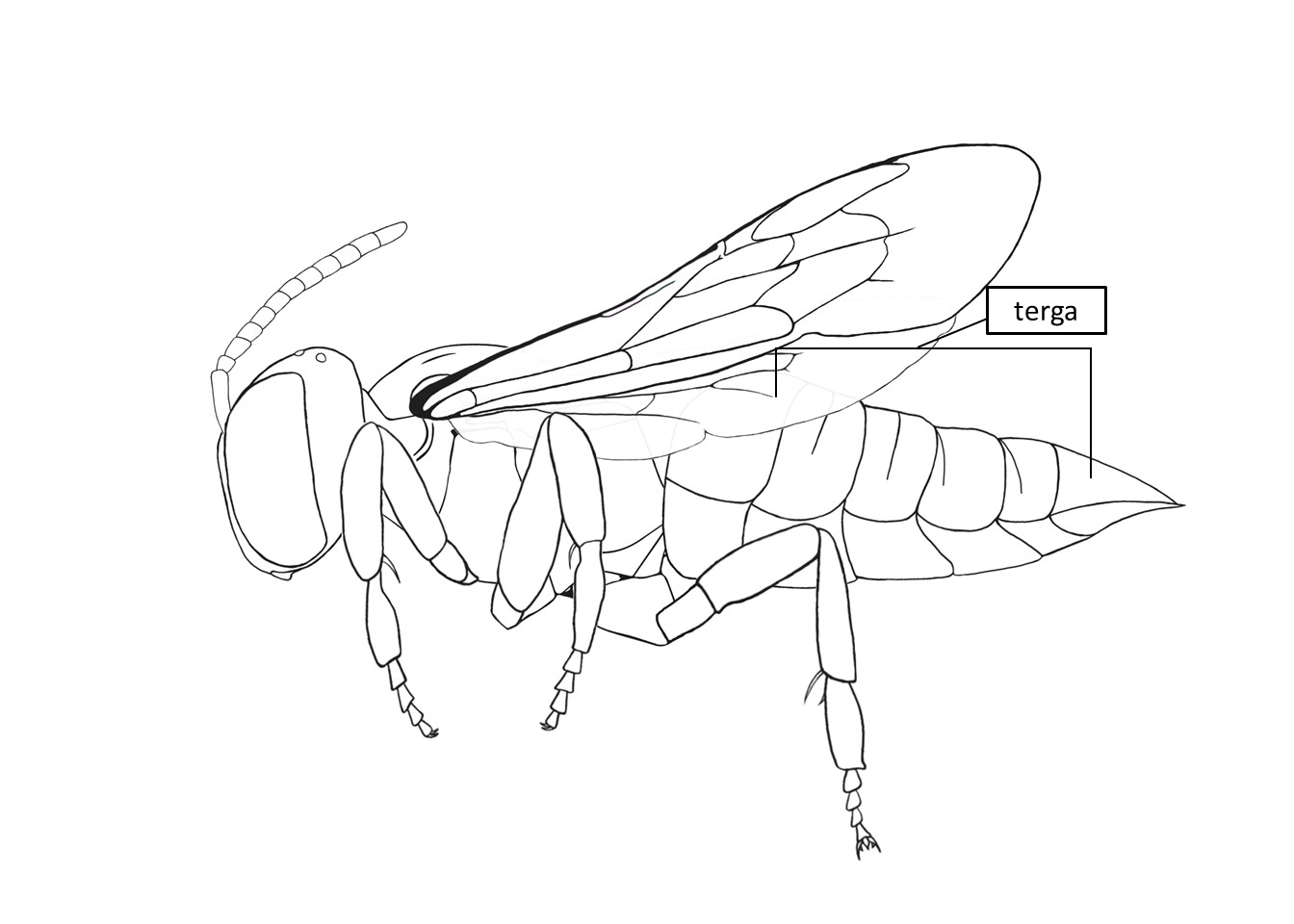Family: Megachilidae
Subfamily: Fideliinae
Tribe: Neofideliini
Genus: Neofidelia Moure and Michener, 1955
Subgenera: none
Common name: none
Neofidelia are robust, medium-sized bees that range in body length from 9–12 mm (Michener 2007Michener 2007:
Michener, C.D. 2007. The Bees of the World (2nd ed.). Johns Hopkins University Press, Baltimore and London, 953 pp.). They are black with dense and long light-colored hairs covering their body (Michener 2007Michener 2007:
Michener, C.D. 2007. The Bees of the World (2nd ed.). Johns Hopkins University Press, Baltimore and London, 953 pp.). The basitarsibasitarsi:
the segment of the tarsus that is the nearest to the body of the bee, usually the largest of all the tarsal segments and tibiatibia:
the segment of the leg, between the femur and the tarsus bear long setaesetae:
a still hair-like structure or bristle
that can resemble scopascopa:
modified hairs for carrying pollen; often branched and dense hairs on the hind-leg, or on the ventral surface of the abdomen in Megachilidae
; however, the setaesetae:
a still hair-like structure or bristle
are not used for pollen gathering and instead assist in throwing loosened substrates out the burrow during construction (Rozen 1973Rozen 1973:
Rozen, J.G. 1973. Life history and immature stages of the bee Neofidelia . American Museum Novitates 2519: 1ndash;14.; Michener 2007Michener 2007:
Michener, C.D. 2007. The Bees of the World (2nd ed.). Johns Hopkins University Press, Baltimore and London, 953 pp.). Pollen is carried with the scopascopa:
modified hairs for carrying pollen; often branched and dense hairs on the hind-leg, or on the ventral surface of the abdomen in Megachilidae
on the ventralventral:
of, on, or relating to the underside of an animal, or segment of an animal
surface of the metasomametasoma:
the posterior part of the body
as in most Megachilidae.
(modified from Michener 2007Michener 2007:
Michener, C.D. 2007. The Bees of the World (2nd ed.). Johns Hopkins University Press, Baltimore and London, 953 pp. unless otherwise stated)
 lacks laterallateral:
lacks laterallateral:Neofidelia may be confused with Fidelia due to similar female pygidialpygidial:
the terminal part or hind segment of the body
plates, but can be distinguished by the hind basitarsusbasitarsus:
the segment of the tarsus that is the nearest to the body of the bee, usually the largest of all the tarsal segments and distance between the clypeusclypeus:
a section of the face below the antennae, demarcated by the epistomal sutures and antennal bases mentioned in the diagnostic characteristics (Michener 2007Michener 2007:
Michener, C.D. 2007. The Bees of the World (2nd ed.). Johns Hopkins University Press, Baltimore and London, 953 pp.).
There are no known invasives.
Neofidelia females excavate branched, shallow burrows in the soil (Rozen 1973Rozen 1973:
Rozen, J.G. 1973. Life history and immature stages of the bee Neofidelia . American Museum Novitates 2519: 1ndash;14.). The nest branches terminate in unlined cells that are widened and dug horizontally (Rozen 1973Rozen 1973:
Rozen, J.G. 1973. Life history and immature stages of the bee Neofidelia . American Museum Novitates 2519: 1ndash;14.). Pollen provisions are moistened and packed into the end of each cell. The female uses her modified pygidiumpygidium:
the terminal part or hind segment of the body
to sculpt the provisional mass into a dish-like shape and oviposits an egg into the convexconvex:
curved outward
mass (Rozen 1973Rozen 1973:
Rozen, J.G. 1973. Life history and immature stages of the bee Neofidelia . American Museum Novitates 2519: 1ndash;14.).
Neofidelia occurs from Chile to southern Peru (Dumesh and Packer 2013Dumesh and Packer 2013:
Dumesh and Packer. 2013. Three new species of Neofidelia (Hymenoptera: Apoidea: Megachilidae) from Northern Chile. Zootaxa 3609 (5): 471ndash;483.; Michener 2007Michener 2007:
Michener, C.D. 2007. The Bees of the World (2nd ed.). Johns Hopkins University Press, Baltimore and London, 953 pp.).
Distribution map generated by Discover Life -- click on map for details, credits, and terms of use.
Dumesh and Packer. 2013. Three new species of Neofidelia (Hymenoptera: Apoidea: Megachilidae) from Northern Chile. Zootaxa 3609(5):471-483.
Michener, C.D. 2007. The Bees of the World (2nd ed.). Johns Hopkins University Press, Baltimore and London, 953 pp.
Engel, M.S. 2002. Phylogeny of the bee tribe Fideliini (Hymenoptera: Megachilidae), with the description of a new genus. African Entomology 10:305-313.
Engel, M.S. 2004. Fideliine phylogeny and classification revisited (Hymenoptera: Megachilidae). Journal of the Kansas Entomological Society 77:821-836.
Rozen, J.G. 1973. Life history and immature stages of the bee Neofidelia. American Museum Novitates no. 2519:1-14.